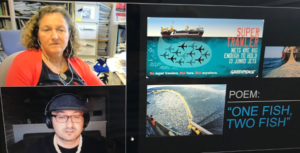Cooperation between science and art can help to protect the ocean. How exactly? An online event organised by DIE, DUK and DAM with international artists and academics addressed this question.
In order to protect the ocean, we need to better understand its ecological function as well as its importance in satisfying diverse human needs. This appreciation for the ocean’s multifaceted significance is what ‘Ocean Literacy’ means. The UN Decade for Ocean Science promotes it as one of its key aims. However, science is not the only discipline engaged in raising awareness or conveying knowledge, as artists often pursue similar goals. The question then becomes how science and arts, respectively, view the ocean and how their modes of engaging the audience can complement each other to promote more holistic forms of understanding and safeguarding it.
On 28 September, the German Development Institute / Deutsches Institut für Entwicklungspolitik (DIE) together with the German Commission for UNESCO (DUK) and the German Alliance for Marine Research (DAM) organised an online event with international artists and scientists to discuss this question. Sculpture artist Adrien Segal, poet Dr. Craig Santos Perez, painter Mbongeni Buthelezi and curator Adrienne Goehler shared examples of their work, which covers issues as diverse as the melting of sea ice, sea level rise, or marine plastic pollution. It impressively combines scientific insights with the evocation of emotional responses. However, as a subsequent panel discussion among the artists, Dr. Angela Pomaro from the Italian National Research Council and attendees from academia, civil society, and the science-policy sphere showed barriers to engaging the public through collaboration between sciences and the arts persist. They stem, among others, from the specific funding structures within both disciplines, which imply temporal but also content-related restrictions, hiding art works behind gallery doors and scientific insights behind paywalls. Barriers also extend to the difficulty of establishing a joint language and a mutual understanding of the methods and the specific logics surrounding reputation and recognition in both fields. Nonetheless, collaborations between science and the arts have the potential to raise awareness by joining information with an emotional sense of affectedness. This forms the basis for recognising the ocean as a habitat, a climate regulator and a cultural good and for promoting ocean health and stewardship.
Learn more about the research on ocean regions at DIE in our web special.

